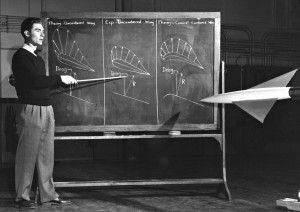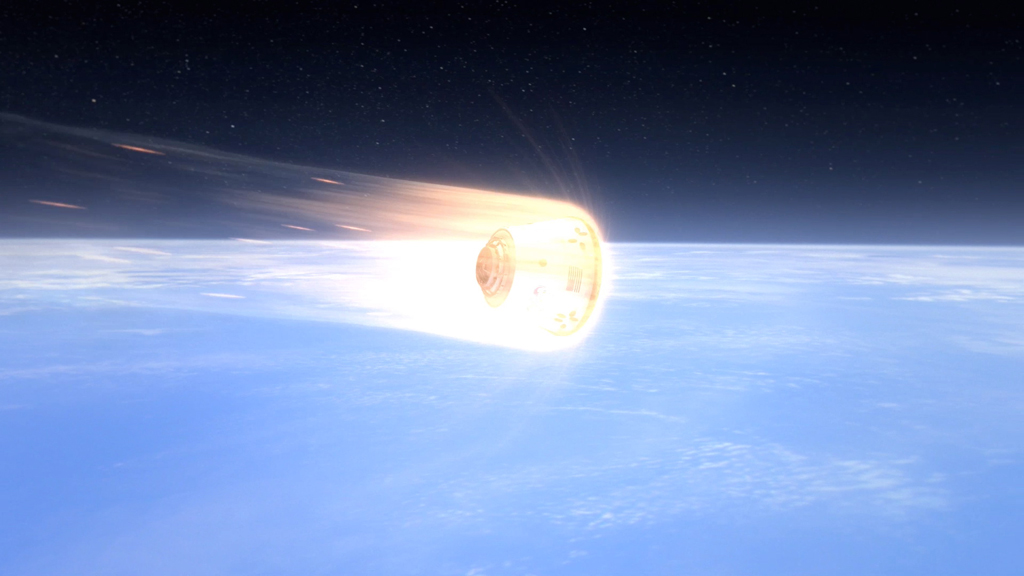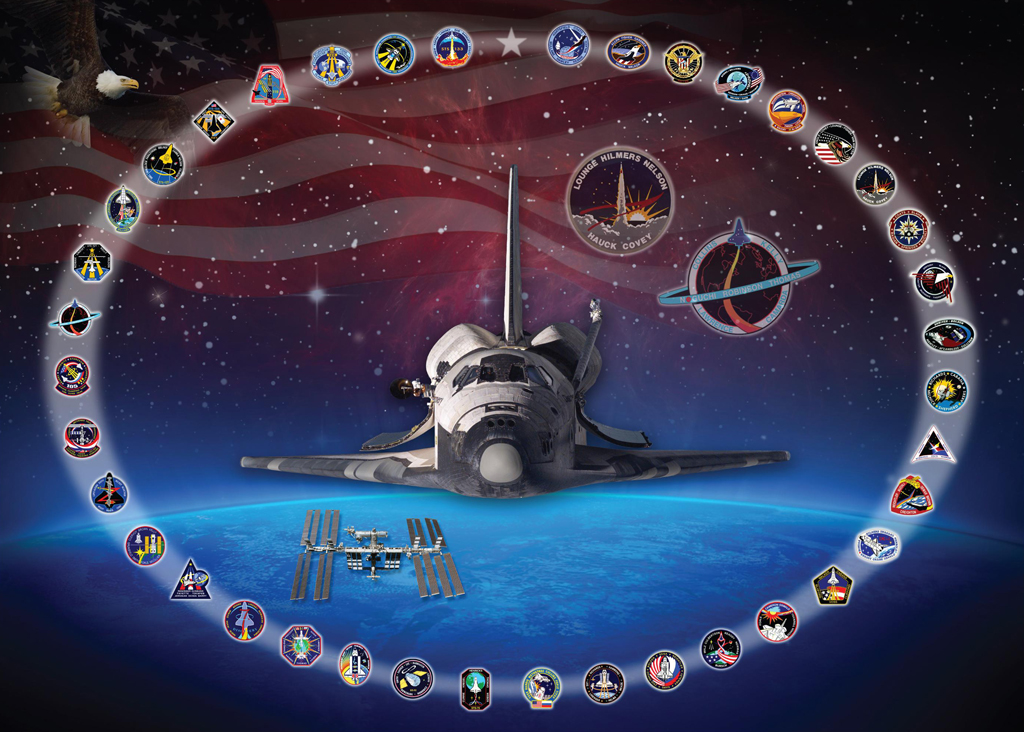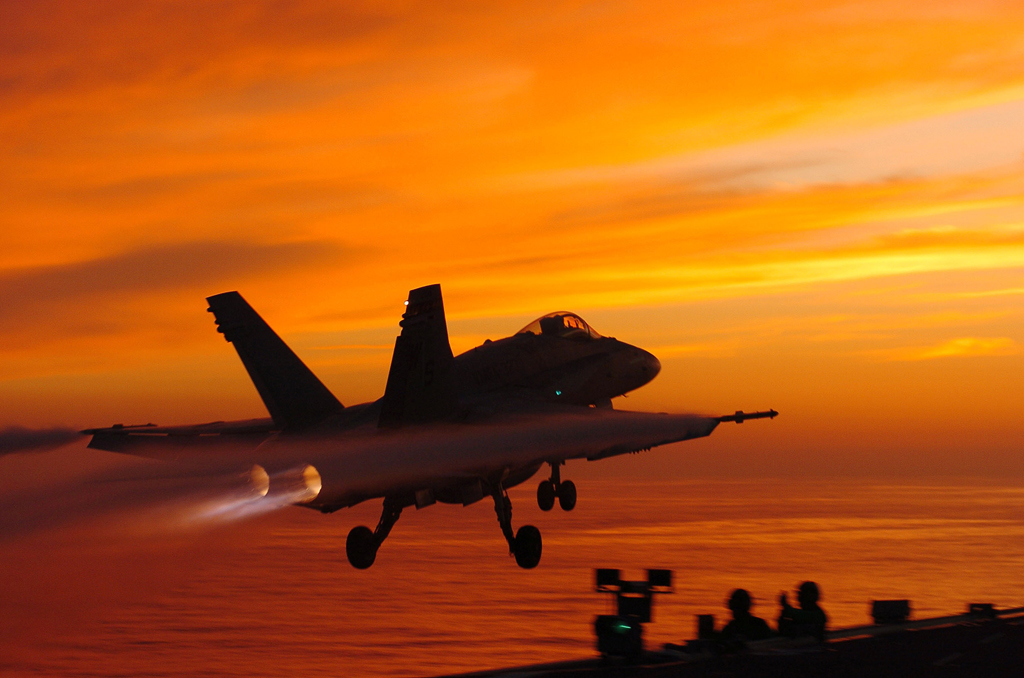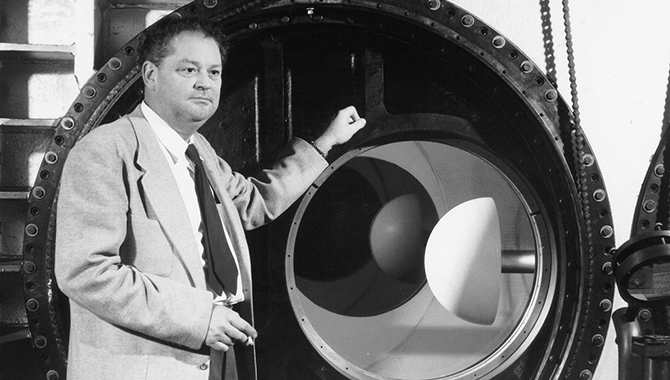
In 1944, I went to Virginia Tech to get my bachelor’s degree in aeronautical engineering. In those days, we finished college in three years because the war was on, which was nice because you got in and out pretty fast.
Langley Field sent interviewers out to our campus to talk to people, but I had been in Virginia all my life, and I wanted to see California. I told the recruiter I didn’t want to go to Langley; I wanted to go to Ames. A few weeks later I got a telegram from Langley that said, we’ve talked to Ames, and here’s your offer: $2,644 per year, take it or leave it. I took it.
Ames sent me an offer but they didn’t say where I was going to work. The lady who talked to me said, “I see you have one course in college in compressible flow aerodynamics [which is like high-speed aeronautics] and we have a little supersonic wind tunnel, so we’re going to assign you to this 1-foot-by-3- foot supersonic wind tunnel.”
There were fantastic people in that facility, people like R.T. Jones, who developed the sweptback wing; Harvey Allen, who developed the blunt-body concept; Walter Vincente, a really outstanding high-speed aero man; Milt Van Dyke; and Dean Chapman. I didn’t realize it at the time, but I worked with eight or ten of the best-known aerodynamicists in the world. As the years wore on, they became the leaders of the aerospace world.
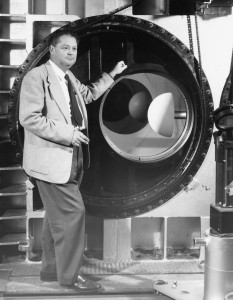
H. Julian Allen stands beside the observation window of the 8-foot-by-7-foot test section of the NACA Ames Unitary Plan Wind Tunnel. Allen is best known for his “blunt-body theory” of aerodynamics, a design technique for alleviating severe reentry heating problems.
Photo Credit: NACA
They told me they were going to let me do a bit of research on sweptback wings, which were kind of new in 1947. At the time, we had to design our models, decide what we wanted them to look like, take the result to the machine shop to get them built, take them to the wind tunnel to test them, and then write a report on the results. You did the whole thing from start to finish.
Learning the Job
I felt intimidated when I started, but everyone encouraged me. It was a very open-minded society in those days, an innovative society. If you had an idea and it had relevance to anything at all, they’d let you pursue it as far as you wanted to take it.
R.T. Jones told me to start reading everything I could find about aerodynamics. For the first three or four months, I just read and talked to people. They didn’t really give me a job. Then one day they told me I’d been around long enough and knew enough about aerodynamics, so I should design a sweptback wing, put pressure taps in it, and test it to obtain detailed pressure forces on the wing. They threw me in to the middle of it, but all the experts around me could answer almost any question. The group I was in had only ten or twelve engineers, so it wasn’t hard to know who to go to, especially with R.T. Jones and Harvey Allen there to help. And I was one of only two or three new employees that year, so they focused on us new employees.
The team in the little wind tunnel was only about twenty people in total: the branch chief and a number of researchers and mechanics. And we had maybe four to six “computers”—the computers were young ladies who sat in a room with a calculator and reduced the data for you. A lot of the engineers in those days literally married their computers. I did not. During all this exciting activity, I had time to meet and marry a beautiful lady, Winnie, and we have five children and nine grandchildren.
The center directors were very close friends of each other and frequently gave each other advice. I remember a visit from the Langley center director who advised us, “If you’ve got a good idea, go try it. If it fails, so it fails; just try another one.” Innovation was really the name of the game.
The bright people at Ames kept us from failing very often. Being among those folks was probably the thing that got me a really good start. Every day six or eight of us would go to lunch together and talk about our work. Harvey Allen had dinner functions and cocktail parties at his home in Palo Alto, and he’d invite the younger engineers to mix with the older ones. The girlfriends some of us had didn’t want to go. They found out the first time that all we talked about was work.
Sharing What We Learned
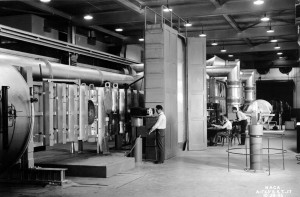
Interior view of Schlieren setup in the 1-foot-by-3-foot supersonic wind tunnel at the NACA Ames Aeronautical Laboratory, Moffett Field, California.
Photo Credit: NACA
We were part of a very open society at Ames, with many open discussions, and all the data we obtained was free to the aerospace industry. They would use the data we got out of the supersonic and subsonic wind tunnels to help design their own aircraft. We also held National Advisory Committee for Aeronautics (NACA) conferences. Each year there was a conference at one of the centers: Langley, Ames, or Lewis. People from academia and the aerospace industry, both military and civil, would attend, and we would present our results from the past year. People including Theodore von Karman, Jimmy Doolittle, Hugh Dryden, Allen, and Jones would come to these meetings—all the bigwigs of the aerospace world. Those conferences, held every year, were key to transmitting NACA information to the industry, as were the NACA reports.
When NACA became NASA, the way we shared things changed some, and I don’t think deliberately. In the days up until 1958, NACA developed technical and aerospace data for industry, and industry was the user of the data. When we became NASA, we became the users of some of the technology ourselves and managers of big projects like Mercury, Gemini, Apollo, and so on. It changed a little bit in how we transmitted the information out.
Innovation from Aeronautics to Astronautics
The air speeds at which we were working in those days were Mach numbers of 0.2 to 2.0, twice the speed of sound. We were making wings more slender and in sharper shapes to go faster more efficiently. In the fifties we at Ames began to think about space thanks to Harvey Allen, who started us thinking this way. He told us that if we were really going to go into space, we’d be orbiting the earth, for example, at 17,000 miles an hour, so we would need to make a blunt body shape to slow down a vehicle when it comes in so it wouldn’t burn up.
That got us thinking about other kinds of things that would be interesting to work on. For example, if we went to Mars and Venus, where the atmospheric gases are different, certainly the aerodynamics would be different, too.
I came across a guy called Zdenek Kopal, who was a famous astronomer who worked at an observatory in the Pyrenees mountains in Spain. We invited him to Ames for a lecture, and he began talking to us about planetary astronomy and gas mixtures on other planets. We were aerodynamicists; we knew nothing about planets. But Kopal and Carl Sagan said carbon dioxide and nitrogen were probably prevalent gases on Mars and Venus. We had a facility here called a free-flight range, which allows you to fire a model into a mixture and take data from it; unlike a wind tunnel, it could be filled with a variety of gas mixtures. We thought we’d fill one of these ranges with a variety of carbon dioxide and nitrogen mixtures and fly different shapes into them to see what the aerodynamics looked like. We got some interesting results. There were differences, not only in the aerodynamics but also in the heating. That got us started down that path of being interested in planetary entry vehicles.
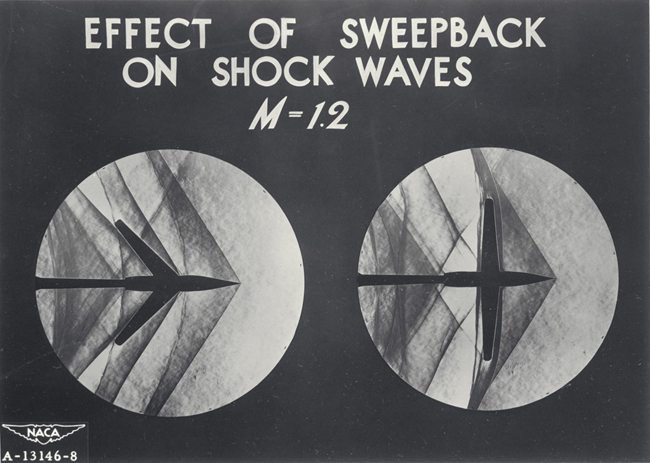
Above: Schlieren photograph of the flow around airplane models showing the effect of
sweptback wings on shock waves at Mach 1.2. Photo Credit: NACA
Had we not started doing this work at NACA before 1958 because we were curious, I think we would never have gotten to the moon when we did. We had a jump-start on the technology we were going to need. Langley, Lewis, and Ames people were working on the technology that led to the application of the lifting-body studies—which looked at the feasibility of maneuvering and landing an aerodynamic craft designed for reentry from space—to Gemini, Mercury, Apollo, and, later, the Space Shuttle. We were not only curious, we had the freedom to pursue that curiosity. In order to fill one of the ranges with gas mixtures, we just asked the guy at the range and he said, “Hey, that sounds like a great idea, go do it.” Our center director was very safety conscious and he made sure it was safe. Many other people did much more detailed research after that; we just started it here.
Simply starting somewhere and sharing what you learn from the experience allows others to take what you learned and keep expanding on it. You never know where things can end up, like landing on the moon. Curiosity can lead to innovation, and continuous learning, even unconventionally, can help keep that curiosity strong.
Continuing Education and Future Innovation
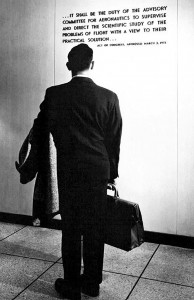
The NACA credo: “It shall be the duty of the Advisory Committee for Aeronautics to supervise and direct the scientific study of the problems of flight with a view to their practical solution. Act of Congress, Approved March 3, 1915”
Photo Credit: NACA
I left NASA in ’85 and went to the University of Texas as assistant to the chancellor for research and was able to teach as an adjunct professor at the Austin, El Paso, and Pan American campuses. I came back to Ames in ’93, and that’s when we started the Aerospace Encounter, an educational program designed to inspire students in fourth through sixth grades about science, technology, engineering, and math. It is still operating today.
The kids cannot run the wind tunnel we use to house the program, but they can use computer workstations to operate a model wind tunnel and see what a big wind tunnel really looks like. We also have a computer program that lets them design their own airplanes. They pick an engine, a body shape, wing type, and a destination—like flying from San Francisco to London—and try to optimize how to do it. If they don’t have the right thrust or number of engines, their design can’t make it, of course, from San Francisco to London. So they have to redesign it. When they create a design that works, the computer alerts them to their success, and they can print out their design and take it away with them.
The kids taught us something we knew early on: they were unconstrained in their thinking. For example, they would design an aircraft that looked like a blimp with little wings on it. It wouldn’t go anywhere at high speeds because the drag was too high, but their minds were open to almost anything.
I talk to students a lot. I’ve got an arrow chart explaining that it’s going to be up to them what we do in the next fifty years. That chart says we’re going to explore the moon, we’re going to explore Mars, we’re going to explore the solar system. And then there’s the end of the arrow. My grandson asked, “What are you going to put in that arrow, sir?”
I said, “I don’t know. What do you think?”
He said, “Why don’t you put the words ‘quantum gravity machine?’ I think Einstein was wrong. We can go faster than the speed of light, and I’m going to prove it, and that’s what I’m going to call it: quantum gravity machine.”
It’s been two years now, and so far I’ve seen no sign of the machine, but he’s still working at it. If we’re going to pursue human exploration of Mars using current chemical propulsion, it would take nine months to get there and nine months to get back. That’s just unacceptable. With my grandson’s quantum gravity machine, it would take about 4.5 minutes to get to Mars.
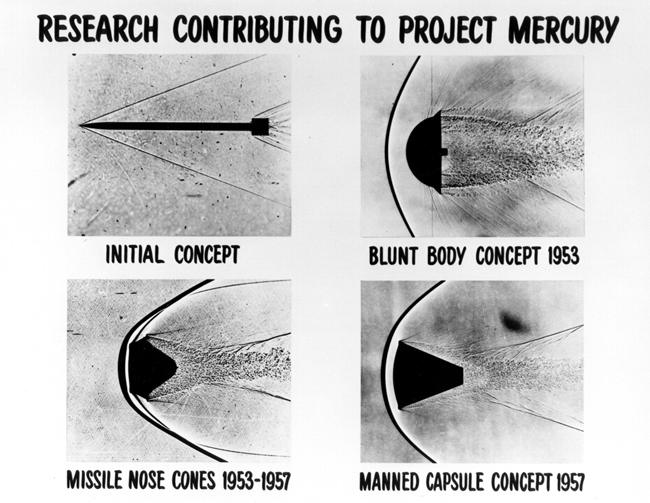
Above: These four shadowgraph mages represent early reentry vehicle concepts: Research contributing to
Project Mercury—Initial Concept, Blunt Body Concept 1953, Missile Nose Cones 1953-1957,
Manned Capsule Concept 1957. Photo Credit: NACA
I like to talk to children because they’re open to almost anything. They don’t care what kind of questions they ask you. They aren’t inhibited. They’ve taught me to keep my mind more open. The mind closes as you get older; you get your own set of ideas and believe you must be right. You’re not quite as open to learning new things. With Aerospace Encounter, you’re constantly surprised by the questions kids ask, which is part of why it’s so great.
The average age at Ames was about 27 years old when I started. Now it’s around 50 years old. So we really need to get the young blood flowing here. But we need to do it while preserving the history that has come before.
Preserving and communicating NASA history keeps us from making the same mistakes twice, hopefully. It also sets a shining example of what this country can do when it puts its mind to it. I don’t mean just landing on the moon; I mean the whole spectrum of things we’ve done. Look at what NASA has accomplished and think about how the first airplane flew in 1903. Just over one hundred years later, look what we’ve done. We’ve gone to the moon, we’ve gone to Mars robotically, we’ve flown out of the solar system, beyond planets, over to Pluto. These are remarkable things. We need to pass on what we’ve learned from it all so we can keep doing remarkable things in the future. The kids are our future. They will develop the innovative technology that will permit us to further explore our solar system and beyond.






